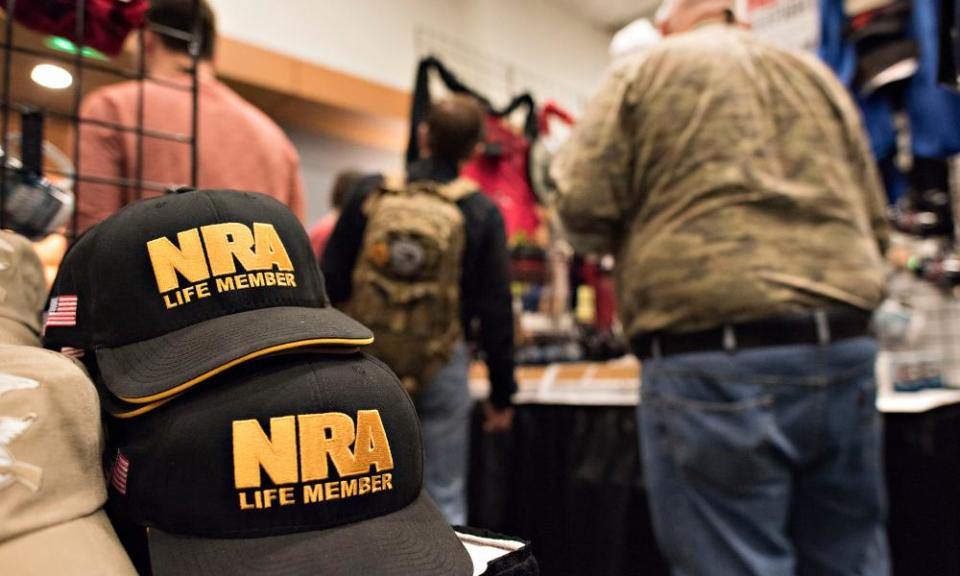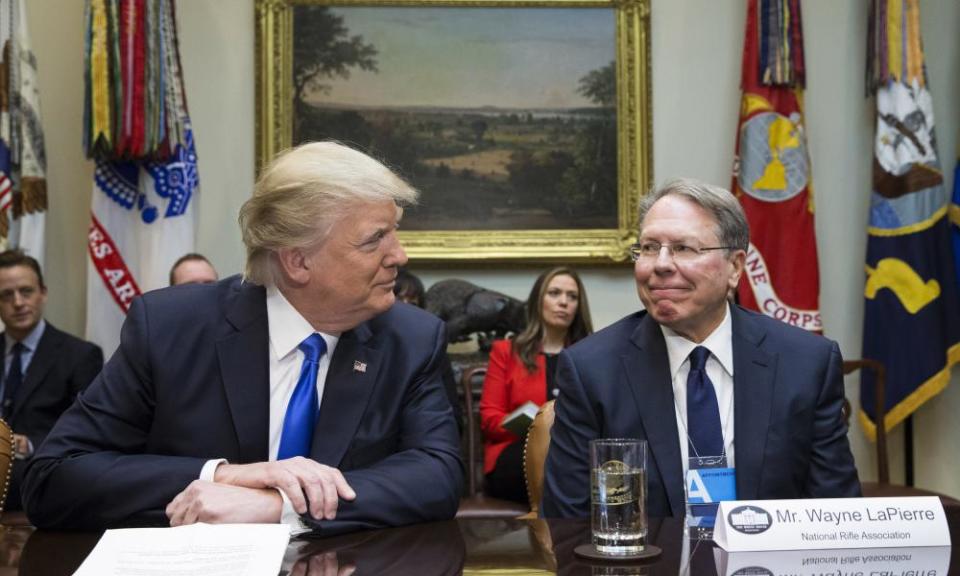The 'Trump slump': gun sales decline as fears of tighter controls fade
Barack Obama was called the ‘best gun salesman on the planet’. But with Trump in the White House, gun companies’ sales are down, and profits are falling

After years of buying up military-style rifles out of fear that the government would ban them, firearms industry insiders say, some Americans may finally think they have enough guns.
Since the election of Donald Trump, who called himself the “true friend” of gun rights activists, stock prices of gun manufacturers have fallen, and American retailers have reported slowing sales of guns and firearms accessories.
The number of gun background checks processed each month, a rough proxy for gun sales, has dropped compared to last year, except for May, the month a suicide bomber attacked an Ariana Grande concert in Manchester, England, leaving 22 people dead. Major terrorist incidents have been shown to drive increased sales in the past.
“The fact that everyone perceived Obama to be anti-gun and wants to take your gun rights away made everybody buy, buy, buy until everybody had a surplus,” said Jeremiah Blasi, the marketing director for Mid America Armament, a small firearms and firearm accessories manufacturer based in Pryor, Oklahoma.
“I think people have gotten … I think I’d use the word complacent,” Blasi said. Because Trump appears to be supportive of gun owners, “nobody’s as concerned that we’re going to lose gun rights in the immediate future”.
It’s the great irony of America’s gun debate: anti-gun politicians boost profits for the firearms industry, and pro-gun politicians hurt them.
The perverse dynamics of the gun market have long turned political attempts to change the role of guns in American life into massive marketing campaigns.
Barack Obama, who led the most serious push for tougher gun control laws in more than a decade, was called “the best gun salesman on the planet”. In contrast, the current president’s influence on the gun industry has been labeled the “Trump slump”.

Blasi said Mid America Armament’s sales were down about 25% compared with last year, and sales at gun shows had dropped even more steeply, about 50%.
The company builds both AR-15-style rifles and firearms accessories. But it is currently focused more on selling accessories than the guns themselves.
“The market really seems saturated. A lot of people are still doing upgrades and builds, but not a whole lot of rifle purchases,” he said. “Even on the accessories end, there’s been a slowdown.”
Major manufacturers have also felt the hit. The stock prices for Sturm Ruger and American Outdoor Brands Corporation, formerly Smith & Wesson, dropped sharply after election day, and after rebounding this spring fell again.
Cabela’s, an outdoor goods retailer, reported a 9% drop in store sales in its second quarter this year and blamed the weakness in gun sales. “Since the fall election, we have continued to see a slowdown in firearms and shooting-related categories,” the company’s CEO, Tommy Millner, said in a statement in early August. The retailer acknowledged that the mass shooting at the Pulse nightclub in Orlando last year had also driven sales up.
Year-on-year comparisons of gun sales, however, show that in spite of the marked fall, sales of guns in America are still at a relative high point. More than 14 million background checks had already been processed by the end of July, which is more than the year-end totals for any year between 1998 and 2009, the final years of Bill Clinton’s presidency and the two terms of George W Bush’s presidency.
“Reports of the industry’s pending demise are greatly exaggerated,” Mike Bazinet, a spokesman for the National Shooting Sports Foundation, the firearms industry trade association, wrote in an email. “2017 is still a very strong year by historic standards and, in fact, we are on track to see the second or third highest year since the [background check] system began.”
Fear of violent attacks and fear of government crackdowns on gun ownership have long been recognized as twin drivers of American gun sales. The number of firearm background checks processed each year, an imperfect but rough proxy for gun sales, jumped from about 13 million a year in 2008, the year Obama was elected, to 27.5 million a year in 2016, the last year of Obama’s presidency.
After the massacre of 20 first-graders and six adults at Sandy Hook elementary school in Newtown, Connecticut, in 2012, prices for some military-style rifles more than doubled, with cheaper Chinese guns rising from $100 to $500 and higher-end rifles going from $700 to $1500, Blasi said. The Sandy Hook shooter had used a military-style Bushmaster rifle, and some gun owners assumed the federal government might renew a ban on military-style “assault weapons” that had lapsed eight years before.
The 1994 assault weapon ban, which targeted many weapons comparatively rarely used in crimes, produced no evidence of life-saving impact, researchers concluded. Some experts have speculated that Democrats’ choice to target military-style guns actually fueled their popularity, and pushed them from the fringes of the firearms market to a central driving force in gun sales. The continued threat of an assault weapons ban has, perversely, continued to drive their popularity, even though researchers concluded that a tougher renewed ban’s effects on gun violence “are likely to be small at best and perhaps too small for reliable measurement.”
There were at least 265m guns in American civilian hands in 2015, according to the most rigorous recent academic survey, although other estimates put the number even higher. Those millions of guns are highly concentrated, with just 3% of American adults owning half of the country’s guns, researchers found. These gun super-owners own an average of 17 guns each.

